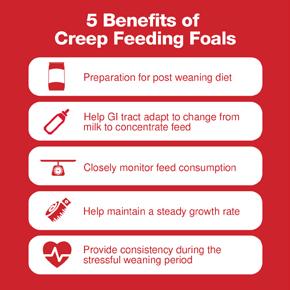
5 minute read
ASK THE NUTRITIONIST?
Ask the Nutritionist MARY BETH GORDON, M.S., Ph.D., EQUINE RESEARCH AND NEW PRODUCT DEVELOPMENT DIRECTOR, PURINA ANIMAL NUTRITION SPECIAL ADVERTISING SECTION
?Ask the Nutritionist is a monthly column featuring questions answered by PhD equine nutritionists and sponsored by Purina Animal Nutrition. Have a nutrition question you want to see featured? Email Marie Rosenthal. For clinics looking for specific nutritional advice, visit purinamills.com/ask-an-expert.
Do my clients really need to creep feed their foals?
It’s that time of year when foals arrive or are already on the ground, and we’re quickly approaching weaning. The best foal feeding advice to give your clients is to creep feed their foals. Creep feeding requires a specialized feeding environment that allows the foal to access feed but does not allow the mare access. Creep feeding enables foals to become accustomed to the diet they will consume post-weaning and enables their GI tract to gradually adapt to the change from milk to concentrate feed.
Creep feeding also allows you and your clients to better monitor foal feed consumption because the mares and foals are no longer eating together. In a traditional feeding setup, some mares will allow foals to consume as much as they like, but others don’t let foals consume anything. Providing foals with individual access to feed ensures a more precise supplemental feeding method, plus you can monitor what and how much the foal consumes each day. Individual feeding also allows you to creep feed the foal based on its age, bodyweight and body condition score.
OVERCOMING OBJECTIONS Creep feeding may seem unnecessary or cumbersome to your clients. After all, aren’t the foals getting all their needs from the dam’s milk and what they eat from the dam’s feeder or pasture?
If your client relies solely on mare’s milk for adequate nutrients for the suckling foal, then suddenly removes milk at weaning while adding concentrate feed and more forage, the rapid change can create a nutrition gap. In some cases, weaning-time stress causes foals to go off feed. Foals may burn more calories from increased whinnying and running around looking for their dams. To reduce stress to the mare and foal during weaning, your clients must provide constant, supportive and familiar nutrition to the foal. Creep feeding keeps foals eating and ensures consistency in their life.
Foals weaned without creep feeding must catch up on nutrients they may have missed during the weaning process and can experience compensatory growth after the sudden addition of concentrate feeds and additional forage. This catch-up period or rapid growth can contribute to the development of a variety of orthopedic problems ranging from contracted tendons to other developmental orthopedic diseases (DODs).
SETTING IT UP It may require some creativity to develop a creep feeding program that works for your client’s barn or facility. Use specialized feeders and fencing configurations in pastures or creep feeding buckets in barn stalls. When setting up creep feeders in pastures, foals should be grouped with their contemporaries by age or bodyweight to ensure they receive proper amounts of feed and that larger, more dominant foals do not overeat. Creep feeding is worth the time and effort to implement individual foal feeding strategies. Foals get the right nutrition in proper amounts, so they maintain a steady growth rate, which contributes to the sound and healthy growth of their bodies.
Contact a Purina Ph.D. nutritionist for consultations through Purina Customer Service, 800-227-8941 or send us a message at www.purinamills.com/ask-an-expert.
April: Special needs of the competition horse May: Endocrine disorders June: Infections UPCOMING TOPICS
Have a question you want to see featured? Send them to modernequinevet@gmail.com.
ABOUT THE AUTHOR Dr. Mary Beth Gordon, M.S., Ph.D., is the Equine Research and New Product Development Director at Purina Animal Nutrition. She studies the effect of nutrition on horse health, separating trends from true efficacy.
Does Doxycycline Placenta? Cross the
By Paul Basilio

Medical Illustrator: Jennifer Oosthuizen Evolving antimicrobial resistance offers many obstacles for the practicing clinician, and the continuing expansion of the veterinary armamentarium is vital to equine health. However, there are little data on the transplacental diffusion and toxicity of antimicrobials in the mare.
“If you have been in clinical practice long enough, you’re going to be faced with the question of whether a drug is safe to use in a pregnant mare,” said Igor Canisso, DVM, MSc, PhD, DACT, DECAR, assistant professor at the College of Veterinary Medicine at the University of Illinois Urbana-Champaign. “Most of the time, you’re going to end up with a question mark on your face, because you don’t know the answer. Very few drugs have been studied to the point where we know about their safety in pregnant mares or even if the drug diffuses to the fetal fluids. We make a lot of assumptions.”
Dr. Canisso, who spoke here at the 65th Annual AAEP Convention in Denver, said that he recently became more excited about doxycycline and its potential in pregnant mares. The drug has great tissue penetration compared with the older drugs in its class, and it’s relatively safe in the horse. For example, anecdotal evidence suggests that prolonged administration of oxytetracycline can cause colitis, but not so with doxycycline.
“If you read [the literature], you can see that with some of the ‘odd’ diseases that we don’t see every day, doxycycline is there to save you,” he said.
Oral doxycycline has been shown to have good effect against granulocytic anaplasmosis, Potomac fever and Lyme disease, to name a few conditions. Dr. Canisso has used it for outbreaks of Shutterstock/Pavlina Trauskeova
The Science of Advanced

The Prestige ®
line of equine vaccines delivers industry-leading technology:


• Flu-containing vaccines with the most updated flu strains available • Antigen Purification System™ (APS), reducing undesirable injection site reactions • Exclusive Havlogen® Adjuvant for consistency and potency in every dose • Prestige® EquiRab®, the original equine-specific rabies vaccine

Demand Prestige ®
for its core to risk-based spectrum of protection
Learn more at PrestigeVaccines.com.







